Olle Trail takes travelers off the beaten path
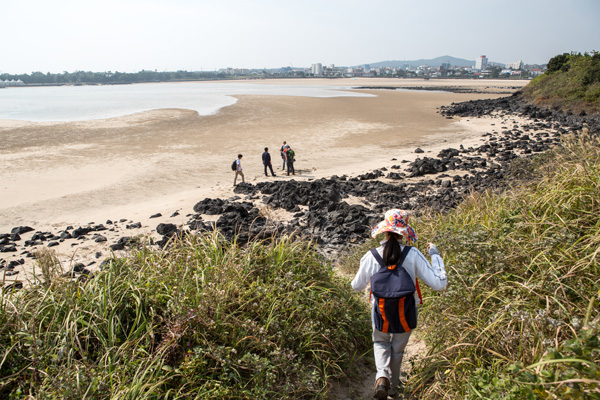
The tour begins with a 1-mile stroll along Olle Trail’s third course, passing a shrine for lost fishermen and divers and a shack used by haenyeo, the island’s famed female divers, and ending at Pyoseon Haevichi Beach.[Olle trail walk]
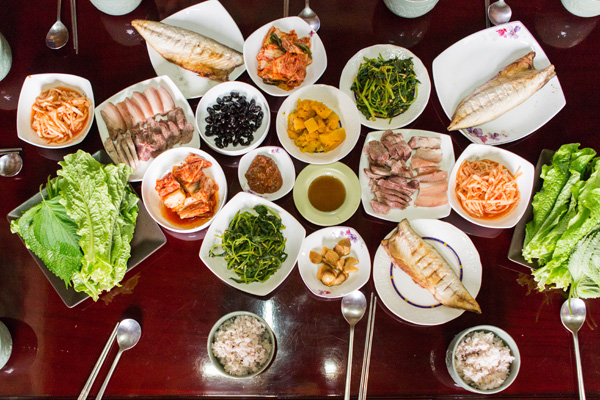
At Sinpung Village, the group visits the home of a local and enjoys a feast of pork and mackerel, with vegetables including cabbage, peppers, canola flower and pumpkin grown in the garden out back.[Lunch, Jeju-style]
To walk the entire route would take weeks, but the Jeju Olle Foundation, the trail’s caretaker, now has a guided program for visitors to experience the trail - or at least, parts of it - in one day.
A Day Away Awesome Jeju, a series of one-day tours tailored for foreign visitors, was launched by the foundation on Sept. 18 and will continue each weekend until Nov. 14.
Participants can choose from among three itineraries that explore different parts of the island’s southern half, which is administered by the Seogwipo City government. The three routes - east, west and south - each provide “best of” experiences that the foundation selects based on the locale’s geography.
During one tour of the eastern route, the itinerary included a short trek along 1 mile of Olle Trail’s third course, a stroll through a local village and a hike up an oreum, the Jeju dialect word for a parasitic volcano.
Paul Moon, a retired Air Force mechanic who three years ago moved from Seoul to Jeju, leads English-language tours along the trail system’s 26 routes.
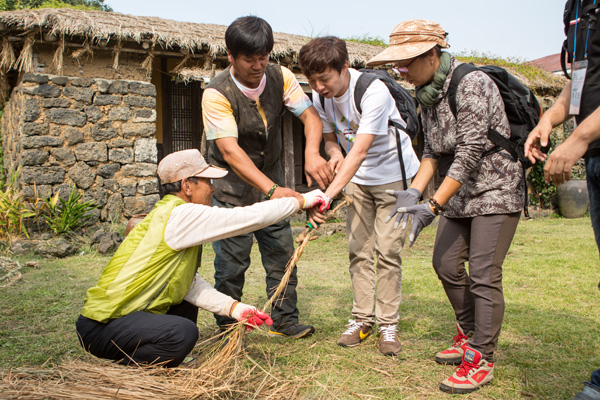
At an experience village, locals guide visitors through the process of making a traditional thatched roof from straw. The porous thatched roofs are ubiquitous on the island due to its strong winds.[Thatched roof making]
A hallabong (orange) tree on the side of the road elicited a briefer on the history of the fruit on the island (they were introduced to Jeju by the Japanese). A break on a stone wall included a primer on the volcanic island’s basalt (the porous rocks make for startlingly windproof walls). Even a light breeze prompted a rejoinder on Jeju’s “three abundances” (the island is known for its strong wind, many rocks and hardy women).
Along the trail, we passed an unassuming white house. A few kept walking before realizing the tour guide had stepped into the house’s backyard. When we hesitated, Moon beckoned us in, and we obliged.
“Isn’t this somebody’s house?” one participant asked.
Moon smiled and led us to a white shack in the middle of the yard. He invited the participant to open the door.
“Is this a trick?” he asked. Moon assured him to go right ahead.
Inside was a shamanistic shrine used by the house’s residents to make private wishes to the gods. This would not be the first time that day we were invited into the private homes of locals. The Jeju Olle Foundation spent six months working with villagers across the island on the program experiences. And parts of the proceeds from the one-day tour programs, which cost 64,000 won ($56) per person, go to the villages.
After the shrine, we continued down the road and onto a path of basaltic rocks that led down to Pyoseon Haevichi Beach. As our feet touched the sand, small crabs scurried away into holes in the sand. In the distance, we could see two riders on horseback racing across the sand, the horses sometimes splashing in the water.
“Who’s hungry?” Moon asked us as the path took us off the beach. We piled into a bus and headed to Sinpung Village.
Lunch was at the home of Mrs. Chang, who had lovingly prepared a Jeju-style meal of mackerel and pork with home-grown vegetables. After lunch, the guide showed us the garden just outside the kitchen walls.
“In Jeju, food travels the shortest distance,” he said.
After lunch, we walked over to the folk village next door, where its manager, Mr. Shin, showed us how to make a traditional thatched roof, a common structure on this windy island.
On the ground were bundles of straw collected from fields nearby. Our task was to use traditional wooden tools to tightly bind the straw into rope. Mr. Shin introduced us to Mr. Oh, a man from the village who guided us through the process.
For a structure made of straw, the thatched roof is surprisingly strong, though the hollow spaces eventually become home to all sorts of animals, including worms and snakes.
“But in traditional Jeju shamanism, snakes are good luck,” noted Moon, who has found snakes in his own thatched roof.
During the autumn harvest, the straw is left to dry, and in the wintertime villagers create the roofs, which are replaced every two years. Mimicking this practice, our group spread a layer of thatch on the roof of a tiny shack and tied it down with rope.
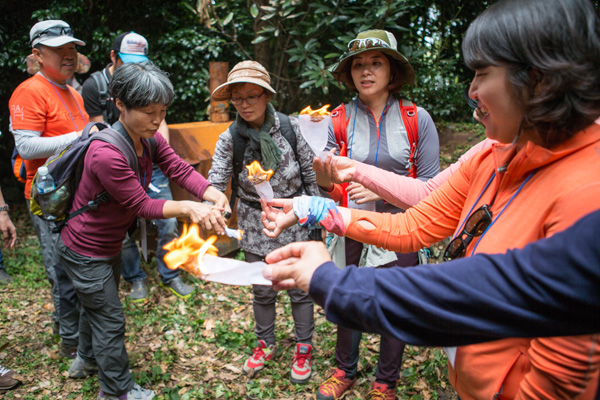
At a shamanistic shrine in the forest of Sinpung Village, tour participants pour a shot of soju for the gods and burn pieces of white paper to signify wishes rising to the heavens.[Wish-making ceremony]
From Sinpung Village, it was another short bus ride to the Kim Young Gap Gallery. Kim was a photographer who spent much of his life documenting Jeju’s landscape before Lou Gehrig’s disease left him immobile.
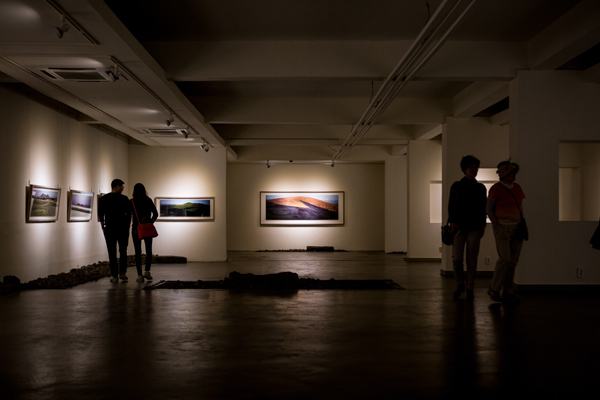
The renowned photographer spent much of his life documenting Jeju’s quiet beauty and iconic oreum, small volcanoes that dot the island, before converting an old elementary school into a gallery.[Kim Young Gap Gallery tour]

The tour ends with a hike up photographer Kim’s favorite oreum, Yongnuni Oreum, passing by tombs. The peak offers views of the island’s rolling landscape.[Oreum hike]
The oreum are referred to as “the mother of Jeju,” Moon said, “because the small volcanoes resemble a mother’s breast.” Indeed, on our hike up Yongnuni Oreum, we saw grave sites along the way, as people are said to “return to the oreum, to Mother Nature” after death.
The one-day program offered by the Jeju Olle Foundation fits well into an island vacation itinerary, especially for those who decide to spend a few days or a week here. But attracting visitors poses a challenge. Of the 10 million tourists who visit Jeju every year, only one million walk the Olle Trail.
And of the two million non-Korean tourists, 85 percent are Chinese, who are often more interested in shopping at Jeju’s duty-free shops than enjoying the island’s rustic culture. But the program may have an audience with people looking for an experience off the beaten path.
“We are targeting people who want to know the real Jeju,” said Kai Huang of the foundation’s planning department. “We want to offer something authentic, to show visitors how Jeju people live.”
In addition to the new one-day program, the Jeju Olle Foundation also organizes the annual Jeju Olle Walking Festival, which runs this weekend from Oct. 30 to 31 and offers visitors a chance to experience local culture along the trail. For more information on both programs, visit www.jejuolle.org.
BY GAVIN HUANG [gavin.a.huang@gmail.com]










with the Korea JoongAng Daily
To write comments, please log in to one of the accounts.
Standards Board Policy (0/250자)